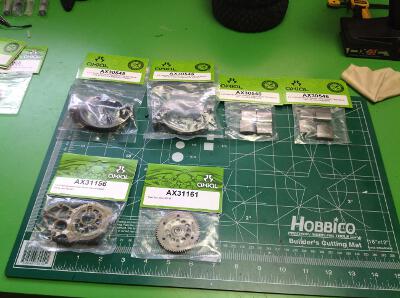Axial RR10 Bomber Project
Page 2: Upgrades!
This image shows a whole pile of upgrades. These are all genuine
Axial parts intended for this model. They are a mix of things
being added to solve problems and also just things I thought were
cool. More upgrades were made later in a second wave. I
don't know what it is about their "titanium" anodize color, but I really
like it.
The first problem I wanted to solve was rollovers. The model
proved quite unstable at speed while trying to make any kind of turn due
to high CG and lack of differentials. I added a wheel weight ring
to each of the 4 wheels which adds 4oz (114g) per corner. The
rings clamp around the outside of the wheel center and end up completely
hidden inside the tire. I
wanted even more weight on the front wheels to improve climbing
traction, so I filled the slots on the weight rings with 6 weights
bringing the total at each front wheel to 8.5oz (240g). This made a
huge difference. Of course, it also means a lot more rotating
mass for both the motor and steering servo to deal with. It also
means no more wheelies.
As long as I was tearing things apart, I decided to add the Axial
aluminum motor mount. You can see the cam system that is used for
mesh adjustment here. Instead of loosening screws and translating
the motor to adjust mesh, you rotate the cam ring. This is
convenient in one way, but rotation of the motor can really mess up the
wires if they are direct soldered as I did.
I stripped a couple of teeth off the plastic spur gear when I hit a curb
under power (you can see the mangled teeth if you zoom in on the left
hand image). Since it was fairly difficult to access and replace,
I didn't want it to happen again. I installed a steel spur.
This requires new slipper clutch pads because the adhesive can't really
be removed from the old spur. The sound of the vehicle is now
totally different with metal contact on all the gears.
I also wanted to change the external appearance. A YouTube video
from RCSparks alerted me to the existence of these aluminum body panels
out of Korea and I had to have them. They are a direct replacement
and really make it look nice, in my opinion. The blue anodize
matches the servo and the springs nicely. The above pictures
show the stock and updated panels. In the second image you can
also see the white paint I added to the raised letters on the tires
using a paint pen.
There have been a lot of broken parts on this model, many of which can
probably be attributed to the increased weight in the wheels. The
first major issue was the fracture of the diff locker as shown. I
replaced it with a Hot Racing steel version. As a structural
engineer, I recognize this as a very bad design. The rotating
flattened axle acts as a wedge which attempts to open the slot, and all
the stress concentrates at the sharp corner. This wouldn't be so
bad except that the sharp corner coincides with the thinnest part of the
wall. The whole problem could be fixed by rotating the slot 45
degrees within the locker.
The next major problem was the loss of the steering link. It fell
off in a rock pile and I couldn't find it. It was not retained
well by the ball joints. I replaced the missing part with some
titanium links as shown on the left. Even the new parts had
problems later as the rod end kept pulling out of the threads, again
probably due to the increased wheel weight. I tried some Boom
Racing one piece arms as shown on the right, but these had terrible
wobble and backlash and were unusable so I reverted to the titanium
links with an epoxy repair.
The next problem I encountered was elongation or fracture of the rod
ends on the front 4-link bars as shown. This happened over and
over even as I kept replacing them. The geometry of the 4-link is
such that extreme loads are applied due to vertical loads such as
landing a jump. Once the rod ends are elongated, the suspension
becomes very sloppy affecting the steering and overall stability.
Again I turned to some Boom Racing solid links. Since these are
solid one piece parts with no separate rod ends I figured they would be
indestructible. Wrong. The ball ends are pressed into the
aluminum with serrated retainers and migrated out almost immediately
rendering them even sloppier than the stock parts. I think the
final solution will be to go back to the old parts and remove the wheels
weights that are causing so many problems.
Update: I ended up removing the wheel weights and reverting
to the stock aluminum links with some steel rod ends from RC4WD.
This actually makes the model run much better. It is back to
rolling over pretty easily, but that can be resolved with some throttle
control.
©2018 Eric Albrecht
